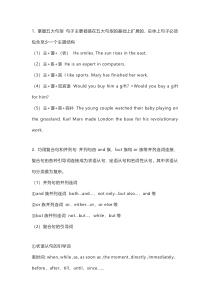 DOC
DOC
【文档说明】高考英语作文高分秘笈.docx,共(6)页,16.763 KB,由小魏子文库上传
转载请保留链接:https://www.ichengzhen.cn/view-239913.html
以下为本文档部分文字说明:
1.掌握五大句型句子主要都是在五大句型的基础上扩展的,总体上句子必须包含至少一个主谓结构(1)主+谓+(状)Hesmiles.Thesunrisesintheeast.(2)主+系+表Heisanexpertincomputers.(3)主+谓+宾Ilikesports.Maryhasfini
shedherwork.(4)主+谓+双宾语Wouldyoubuyhimagift?=Wouldyoubuyagiftforhim?(5)主+谓+宾+宾补Theyoungcouplewatchedtheirbabyplayingonthegrassl
and.KarlMarxmadeLondonthebaseforhisrevolutionarywork.2.巧用复合句和并列句并列句由and族,but族和or族等并列连词连接,复合句由各种引导词连接成为状
语从句、定语从句和名词性从句。其中状语从句分类最为复杂。(1)并列句的并列连词①and族并列连词both…and…,notonly…butalso…,and等②or族并列连词or,either…or,orelse等③but族并列连词not…but…,while,but等(2
)复合句的引导词①状语从句的引导词表时间:when,while,as,assoonas,themoment,directly,immediately,before,after,till,until,since……表地点:wherever,where表方式:as
if/though,(just)as表原因:because,since,as,nowthat表结果:so…that,such…that,sothat表目的:sothat,inorderthat表比较:as…as…,than…,thesame…as…,notso…as…表让步:though,alth
ough,nomatterwh-,evenif/though,as表条件:if,as/solongas,onconditionthat,unless②定语从句的引导词关系代词:who,whom,which,that,as,who
se关系副词:when,where,why③名词性从句的引导词that,whether,if,what,which,when,where,why,how,whatever,whichever,whenever,wherever,howeverHesmiles.
Thesunrisesintheeast.(2)主+系+表Heisanexpertincomputers.(3)主+谓+宾Ilikesports.Maryhasfinishedherwork.(4)主+谓+双宾语Wouldyoubuyhimagift?=Would
youbuyagiftforhim?(5)主+谓+宾+宾补Theyoungcouplewatchedtheirbabyplayingonthegrassland.KarlMarxmadeLondonthebase
forhisrevolutionarywork.3.灵活运用固定框架(1)Itis(high/about)time…是该…的时候了(2)Itis+adj.(kind/nice/good/foolish…)ofsb.todosth.某人做某
事真好/愚蠢…(3)Itis+adj.(important/necessary/impossible…)forsb.todosth.某人做某事是重要的/必要的/不可能的…(4)Idon’tthink/believe/expect/…that从句(否定转移)我认为/相信/期望…不/非…(5)Wha
tissth./sb.like?某人人品怎么样?Whatdoessth./sb.looklike?某物/某人看上去是什么样的?(6)Wouldyoumind…?你介意…吗?(7)Itisnogood/use+doingsth.做某事是不好的/没用的(8)Itis/hasbeen…since…自从…
已有…(9)Itis/was…who/that…(强调句型)就是…(10)Itissaid/reported/believed/suggested…+that从句据说/据报道/人们相信/有人建议…4.掌握扩展句子的手段(1)增加修饰成分名词可以带
有定语、同位语,动词、形容词可以带有状语①Iamastudent.IamaboystudentinClass5,Grade2,No.1MiddleSchool.②Theactoractedintheplay.TheyoungactorfromHunanonceactedverywe
llinthehistoryplay.(2)运用并列和从属手段并列清楚地表现了从句之间的逻辑关系:递进、顺承、转折、选择、因果等;从属则表明了主从句之间的主次关系,恰当地运用从属手段可以使文章表意连贯、主线分明①Thelefthandwas
stillpainful.ThelefthandwasstillpainfulsoIwenttoseeadoctor.②Ilikemusic.Ilikemusivwhilemybrotherlikessports.5.句型转
化(1)肯定句、否定句、疑问句之间的转换ShecomesfromCanada.→Shedoesn’tcomefromCanada.DoesshecomefromCanada?Wheredoesshecomefrom?(2)简单句和复合句的转换①Is
poketothewomanjustnow.Shecanspeakseveralforeignlanguages.→ThewomantowhomIspokejustnowcanspeakseveralforeignlan
guages.②Hegotuplatethismorning.Hedidn’tcatchthefirstbus.→Hedidn’tcatchthefirstbusbecausehegotuplateth
ismorning.(3)并列句与复合句和非谓语动词之间的转换Thefishcaneatapersonintwominutesandtheyleaveonlybones.→Thefishcaneatapersonintwominutes,leavingonebones.6.妙用承接、过渡词语
(1)表示时间顺序now,then,afterwards,later,soon,beforelong,tobeginwith,atthebeginning,atfirst,attheendof,intheend,finally…
(2)表示次序①first,second,third…finally/lastly②firstly,secondly,thirdly…finally/lastly(3)表示空间顺序above,below,near,far,beside,totheright,ononeside…(4
)表示因果关系therefore,so,asaresult,thus,forthisreason,hence,for…(5)表示转折、让步however,nevertheless,atanyrate,inspiteof,yet,but…(6)表示并列
、等同equally,inthesameway,likewise,atthesametime,thatis(tosay),orrather…(7)表示比较、对照by/incontrast,bycomparison,incontr
astto,onthecontrary,ontheotherhand,instead,but,justlike,justas,similarly…(8)表示列举forexample,forinstance,toillustrate,suc
has(9)表示意义增补inaddition(to),besides,and,moreover,futhermore,whatismore,aswell,andthen…(10)表示目的forthepurposeof,sothat,inorderthat,soasto,inorderto…(1
1)表示强调indeed,infact,surely,withoutanydoubt…(12)表示总结、归纳inconclusion,insummary,insum,inaword,inbrief,inshort,thu
s,tosumup,toconclude,allinall…7.如何写好作文段落段落是一组相关的、共同表达一个中心思想的句子组成的。段落本身又是一篇小短文,包括主题句、支持句和结尾句。主题句是一个段落的中心或灵魂,代表着整个段落的主要思想,往往置于段落的首位。支持句是各
种解释、说明、论证主题句的句子。结尾句是由主题句和支持句发展而来,它通常是一种肯定或否定的结论,是对全段的一种浓缩式说明。段落的句式要错落有致,不要单调重复。段落除了用少数简单句以外可穿插使用祈使句和虚拟语气,再辅以复合句和非谓语动词。长句与短句的交替使用使文章更具可读性。
 辽公网安备 21102102000191号
辽公网安备 21102102000191号
 营业执照
营业执照